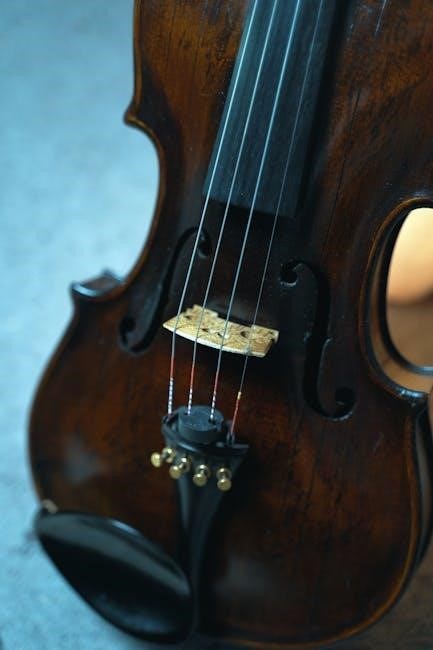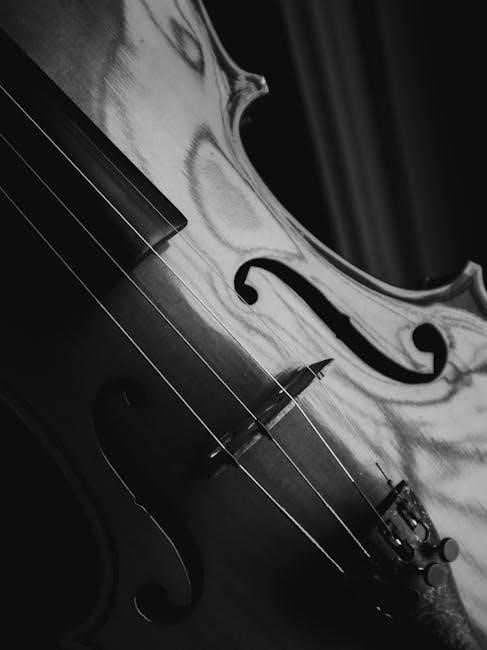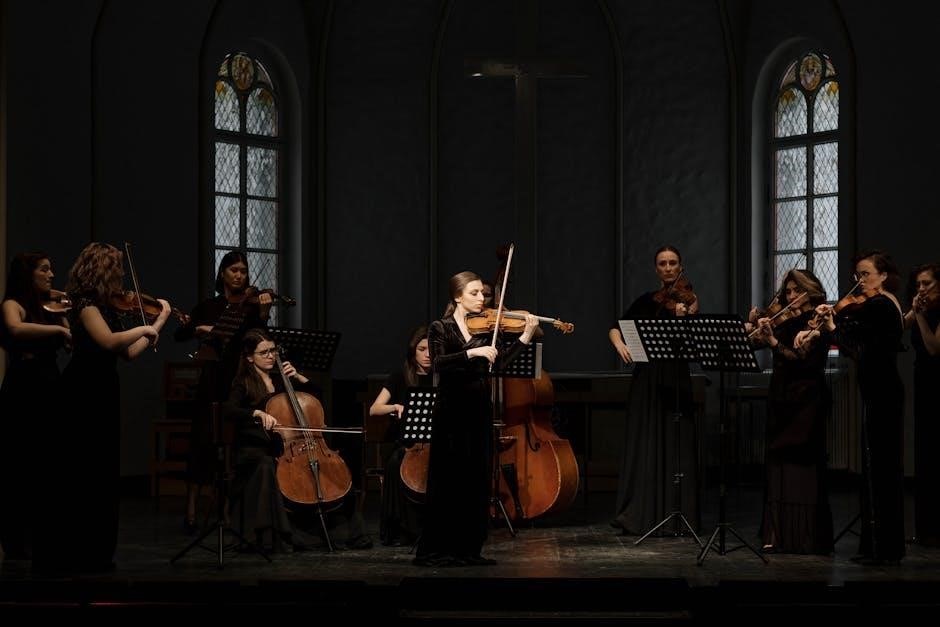Haydn’s Violin Concerto in G Major, Hob.VIIa:4, is a celebrated classical piece, known for its melodic elegance and technical accessibility, making it a favorite among violinists and classical music enthusiasts alike.
1.1 Historical Background of the Concerto
Joseph Haydn’s Violin Concerto in G Major, Hob.VIIa:4, is believed to have been composed during the Classical era, though its exact date remains uncertain. Originally attributed to Haydn, some scholars suggest it may have been written by Leopold Hofmann. The concerto was listed in the Breitkopf catalog in 1769, indicating its early popularity. Despite debates over authorship, it remains a cherished piece, admired for its refined melodies and classical proportions, reflecting the musical tastes of 18th-century Europe.
1.2 Significance of the G Major Key in Haydn’s Compositions
The G Major key in Haydn’s Violin Concerto is notable for its bright, cheerful qualities, often associated with joy and simplicity. Haydn frequently used G Major to evoke a sense of clarity and balance, which complements the violin’s expressive range. The concerto’s key choice aligns with Haydn’s classical ideals, emphasizing melodic grace and harmonic stability. This key selection also highlights the composer’s ability to craft music that is both technically accessible and emotionally resonant, making the concerto a timeless favorite among performers and audiences alike.

Structure and Movements of the Concerto
The concerto is structured in three movements, showcasing Haydn’s mastery of classical form. It includes a vibrant first movement, a lyrical slow movement, and a lively finale.
2.1 First Movement: Sonata Form Analysis
The first movement of Haydn’s Violin Concerto in G Major adheres to the sonata form, featuring a clear exposition, development, and recapitulation. The exposition introduces the primary themes in G major, showcasing the solo violin’s agility and expressiveness. The development section explores these motifs with harmonic richness, while the recapitulation brings thematic resolution. This movement highlights Haydn’s mastery of classical structure and his ability to blend technical brilliance with musical elegance, making it a cornerstone of violin repertoire.
2.2 Second Movement: Adagio ー Musical and Emotional Depth
The Adagio movement of Haydn’s Violin Concerto in G Major is a testament to the composer’s ability to convey profound emotion through music. With its lyrical melodies and expansive phrasing, the movement provides a contrasting yet complementary interlude to the vibrant first and third movements. The solo violin delivers heartfelt themes, supported by a sensitive orchestral accompaniment, creating a moment of introspection and beauty. This movement is often praised for its expressive depth and technical simplicity, making it accessible while maintaining artistic integrity.
2.3 Third Movement: Rondo ー Structure and Musical Elements
The third movement, a lively Rondo, features a recurring theme alternating with contrasting episodes. Its structure follows an A-B-A-C-A pattern, showcasing Haydn’s mastery of form and humor. The solo violin shines with virtuosic passages, including arpeggios and double stops, while the orchestra provides rhythmic support. The movement’s energy and playful dialogue between soloist and ensemble create a captivating conclusion to the concerto, blending technical brilliance with melodic charm.

Sheet Music and PDF Availability
Haydn’s Violin Concerto in G Major is widely available as free PDF downloads from sources like Musopen.org and other classical music archives, offering full scores and parts.
3.1 Sources for Downloading the Score
The score of Haydn’s Violin Concerto in G Major is available for download from various online sources, including Musopen.org, which offers free PDF and MIDI versions. Additionally, platforms like Musicnotes and Sheet Music Plus provide high-quality sheet music for purchase. The concerto is also accessible through classical music archives and libraries, ensuring widespread availability for musicians and enthusiasts. Many versions, including arrangements for violin and piano, are offered in both PDF and MIDI formats, catering to different performance needs.
3.2 Arrangements for Violin and Piano
Arrangements of Haydn’s Violin Concerto in G Major for violin and piano are widely available, offering a practical format for soloists and accompanists. Editions by prominent publishers like CF Peters, edited by Kuchler, are particularly popular. These arrangements maintain the concerto’s original charm while adapting it for duet performance. They are ideal for practice, recitals, and educational purposes, catering to intermediate and advanced skill levels with clear notation and balanced dynamics between the violin and piano parts.
3.3 Free Resources and Copyright-Free Versions
Free resources for Haydn’s Violin Concerto in G Major are readily available online. Websites like Musopen.org offer PDF and mp3 downloads without copyright restrictions. Additionally, platforms provide free sheet music in PDF and MIDI formats, enabling musicians to access and perform the concerto legally. These resources are ideal for students, educators, and enthusiasts, ensuring widespread accessibility and promoting the concerto’s timeless appeal.

Performance and Interpretation
Elizabeth Layton’s performance highlights the concerto’s vibrant energy, showcasing Haydn’s mastery in balancing solo and orchestral elements, making it a timeless classical piece.
4.1 Soloist’s Role and Technical Challenges
The soloist in Haydn’s Violin Concerto in G Major faces intricate passages requiring precision and artistry. Technical challenges include rapid arpeggios, nuanced phrasing, and sustained melodies, demanding both virtuosity and interpretive depth to convey the composer’s intent effectively.
4.2 Orchestral Accompaniment and Continuo
The orchestral accompaniment in Haydn’s Violin Concerto in G Major features a classical ensemble, including strings, woodwinds, and continuo. The orchestra provides a balanced yet vibrant support to the soloist, with harmonic and rhythmic underpinning. The continuo, often realized by harpsichord or cello, adds depth and stability. This interplay between the solo violin and the orchestra creates a dynamic dialogue, highlighting Haydn’s mastery of orchestration and his ability to blend virtuosity with ensemble cohesion.
4.3 Notable Performances and Recordings
Haydn’s Violin Concerto in G Major has been performed by renowned violinists, with notable recordings showcasing its elegance. Soloist Elizabeth Layton delivered a glowing performance with orchestral accompaniment, highlighting the concerto’s charm. Recordings are widely available, including versions by celebrated artists, offering listeners diverse interpretations. These performances and recordings demonstrate the concerto’s enduring appeal and its significance in classical music repertoire.

Instrumentation and Scoring
The concerto features a solo violin accompanied by strings, winds, and continuo. Historical performances often use period instruments, while modern interpretations incorporate full orchestral arrangements, emphasizing clarity and balance.
5.1 Violin Solo and Its Prominence
The violin solo in Haydn’s Concerto in G Major is highly prominent, showcasing the instrument’s technical and melodic capabilities. Its accessible yet musically rewarding nature makes it a favorite among students and professionals. The solo part stands out with its lyrical phrases and virtuosic passages, requiring both precision and expressive artistry. This concerto is often considered a cornerstone of violin repertoire, highlighting the soloist’s ability to blend elegance with technical brilliance.
5.2 String and Wind Instrumentation
Haydn’s Violin Concerto in G Major features a classical orchestra, with strings forming the core accompaniment. The string section provides harmonic depth and rhythmic support, while wind instruments, such as oboes and horns, add color and texture. The orchestration balances simplicity with richness, ensuring the solo violin remains prominent without overwhelming it. This thoughtful instrumentation highlights Haydn’s mastery in creating a cohesive and engaging musical dialogue between the soloist and ensemble.
5.3 Historical vs. Modern Instrumentation
Historically, Haydn’s concerto was performed with smaller orchestras and period instruments, emphasizing clarity and balance. Modern performances often use larger ensembles and updated instruments, enhancing projection and tonal richness. While historical renditions feature gut strings and harpsichord continuo, modern versions employ steel strings and evolved bow techniques. These differences reflect evolving musical practices, yet both approaches preserve the work’s essential character and charm, showcasing its adaptability across eras.

Analytical Insights
Haydn’s concerto showcases his mastery of sonata form, thematic development, and harmonic innovation, blending structural clarity with expressive depth, highlighting his rhythmic and melodic ingenuity.
6.1 Sonata Form in the First Movement
The first movement of Haydn’s Violin Concerto in G Major exemplifies classical sonata form, featuring a clear exposition with thematic duality, a developmental section exploring harmonic contrasts, and a recapitulation that resolves tension. This structure, marked by balance and symmetry, showcases Haydn’s compositional prowess and his ability to blend technical rigor with melodic charm, creating a cohesive and engaging musical narrative for the soloist and orchestra.
6.2 Thematic Development Across Movements
Haydn’s Violin Concerto in G Major showcases thematic development across its three movements, with motifs introduced in the first movement reappearing in varied forms. The expository material in the opening sonata form is expanded and transformed, while the Adagio presents lyrical themes that contrast with the virtuosic elements of the outer movements. The Rondo finale revisits rhythmic and melodic ideas, creating a cohesive narrative that ties the concerto together, demonstrating Haydn’s mastery of thematic evolution and structural unity.
6.3 Harmonic and Rhythmic Innovations
Haydn’s Violin Concerto in G Major features innovative harmonic and rhythmic elements that highlight his compositional genius. The concerto employs modulation to unexpected keys, adding freshness to its tonal structure. Rhythmic vitality is evident in the interplay between the solo violin and orchestra, with syncopation and contrasting tempos enhancing the musical dialogue. These innovations contribute to the concerto’s enduring appeal, showcasing Haydn’s ability to balance tradition with creative experimentation, thereby advancing the classical concerto form.

Editions and Publishers
The concerto is available in various editions, with Kuchler’s version by CF Peters being prominent. Modern editions offer improved readability and historical accuracy for performers.
7.1 Kuchler’s Edition and Its Significance
Kuchler’s edition of Haydn’s Violin Concerto in G Major, published by CF Peters, is highly regarded for its meticulous editing and clarity. It remains a trusted resource for violinists, offering a balanced blend of historical authenticity and practical performance considerations. Kuchler’s work ensures accessibility while preserving the concerto’s original charm, making it a cornerstone for both students and professionals. His edition has significantly contributed to the piece’s enduring popularity and interpretative accuracy.
7.2 Peters Edition and Its Features
The Peters Edition of Haydn’s Violin Concerto in G Major, edited by Ferdinand Küchler, is renowned for its clear notation and faithfulness to the original score. It combines historical accuracy with practical performance considerations, making it a preferred choice for musicians. The edition includes both solo and piano parts, ensuring comprehensive accessibility for performers. Its meticulous editing and Urtext elements make it a valuable resource for interpreting Haydn’s work authentically.
7.3 Modern Editions and Their Improvements
Modern editions of Haydn’s Violin Concerto in G Major offer enhanced readability and corrected historical inaccuracies. These versions incorporate fresh scholarly insights, ensuring a more accurate representation of Haydn’s intent. Digital formats allow for easy access and customization, catering to contemporary performers. Additionally, modern editions often include interpretative notes and performance suggestions, enriching the musician’s understanding and execution of the concerto.

Educational and Learning Resources
This section highlights educational resources, including study guides, practice materials, and online tutorials, helping students and musicians master Haydn’s Violin Concerto in G Major effectively.
8.1 Study Guides and Analysis
Study guides and analytical resources for Haydn’s Violin Concerto in G Major provide in-depth insights into its structure, thematic development, and historical context. These materials often include detailed breakdowns of the concerto’s movements, such as the sonata form of the first movement and the emotional depth of the Adagio. Analysis papers and PDF guides, available from sources like Musopen.org and academic journals, offer musicians and students a comprehensive understanding of the work’s technical and artistic elements, aiding in both performance and appreciation.
8.2 Practice Materials for Students
Practice materials for Haydn’s Violin Concerto in G Major are widely available, catering to students of various skill levels. PDF sheet music, including solo and piano accompaniment versions, can be downloaded from platforms like Musopen.org. These resources often include fingerings, bowings, and phrasings to aid technical development. Additionally, many editions, such as those by Kuchler and Peters, provide detailed markings and performance notes, helping students master the concerto’s challenging passages and refine their interpretation.
8.3 Online Tutorials and Masterclasses
Online tutorials and masterclasses offer valuable insights for studying Haydn’s Violin Concerto in G Major. Platforms like YouTube and music education websites provide video lessons and interactive guides. These resources often include detailed analyses of the concerto’s movements, technical tips, and interpretative advice. Additionally, masterclasses by renowned violinists share professional perspectives, helping students refine their performance. Such digital tools complement PDF sheet music, enhancing the learning experience for aspiring musicians.

Cultural and Historical Impact
Haydn’s Violin Concerto in G Major has left a lasting legacy in classical music, inspiring future composers and remaining a beloved piece in the violin repertoire.

9.1 The Concerto’s Role in Classical Music
Haydn’s Violin Concerto in G Major holds a significant place in classical music history, showcasing his mastery of sonata form and dialogue between soloist and orchestra. Its balanced structure and melodic richness exemplify the Classical era’s aesthetic. The concerto’s emotional depth, particularly in the Adagio, highlights Haydn’s ability to blend technical brilliance with expressive nuance, influencing later composers and remaining a cornerstone of violin repertoire.
9.2 Influence on Later Composers
Haydn’s Violin Concerto in G Major influenced numerous composers, including Mozart and Beethoven, who admired its structural clarity and melodic inventiveness. The concerto’s sonata form and thematic development set a benchmark, inspiring later composers to explore similar dialogues between soloist and orchestra. Its technical demands and expressive qualities also shaped the evolution of violin repertoire, making it a foundational work for classical instrumental composition and performance.
9.3 Popularization in Modern Times
Haydn’s Violin Concerto in G Major remains popular in modern times, with its sheet music widely available in PDF and MIDI formats for free download. Performances by renowned soloists and orchestras continue to captivate audiences, while its inclusion in educational resources and online platforms ensures accessibility for students and enthusiasts alike. The concerto’s timeless appeal is further enhanced by its frequent use in classical music streaming and educational programs.
Haydn’s Violin Concerto in G Major remains a timeless masterpiece, cherished for its elegance and technical brilliance. Its availability in PDF and MIDI formats ensures its enduring legacy for future generations of musicians and enthusiasts.
10.1 Summary of Key Points
Haydn’s Violin Concerto in G Major, Hob.VIIa:4, is a timeless piece celebrated for its melodic elegance and technical accessibility. Its availability in PDF and MIDI formats has made it widely accessible to musicians and enthusiasts. The concerto showcases Haydn’s mastery of classical form, blending structural precision with emotional depth. As a significant work in classical music, it continues to inspire performances and educational efforts, ensuring its enduring legacy in the violin repertoire.
10.2 Final Thoughts on the Concerto’s Legacy
Haydn’s Violin Concerto in G Major remains a cornerstone of classical music, cherished for its melodic beauty and structural brilliance. Its widespread availability in PDF and MIDI formats ensures accessibility for future generations. The concerto’s enduring popularity underscores Haydn’s lasting influence on violin repertoire, cementing its place as a timeless masterpiece in classical music history.
